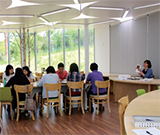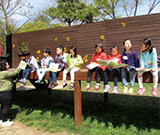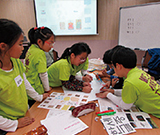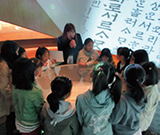스킵네비게이션
Skip Navigation
Education
Programs
Home > Education > Programs
Information
National Hangeul Museum supports education that promotes Hangeul culture through communication and exchanging thoughts. Educational programs are carried out based on the collections of the Museum. These programs promote sharing thoughts and encourage the participants to communicate with one another through listening, speaking, reading and writing. National Hangeul Museum seeks to provide the opportunity for the participants to increase their cultural understanding and grow into creative leaders by offering various educational programs specific to participants’ age, generation and situation.Hands-on Hangeul Culture Programs for International Visitors
- Theme: Hangeul Culture, Korean Language and Korean Script
- Goal: To help the international visitors better understand Hangeul and its culture by offering various opportunities to experience the Hangeul culture
- Target: International group visitors (students, expatriates, workers, multicultural families, etc.)
- Contents: Hangeul culture related to 'music & dance, food, literature, and font'
- Duration: Monday to Friday throughout the year (except Jan. 1st, Seolal and Chuseok holidays)
- Time: 10am to 12pm or 2pm to 4pm (Negotiable)
- Group Size: about 30 people
- Venue: The annex, the auditorium and the main exhibition hall of the National Hangeul Museum
- Fee: Free of charge
- Reservation: Fill up the application and send it to (vvvsound@korea.kr). Confirmation will be made after the details are discussed.
- All programs are in Korean.
- For the guided group tour of the exhibitions, call +82-10-2124-6200 or email to eh1027@korea.kr.
- For the guided group tour of the exhibitions, call +82-10-2124-6200 or email to eh1027@korea.kr.
What are the programs about?
1. Exciting Hangeul
Experiencing the Korean traditional performing art through Bongsan Mask Dance
- What is mask dance?
- Learning about mask dances and Bongsan Mask Dance, characters and terms featured in Bongsan Mask Dance - Visit to the permenant exhibition
- Learning the principles of Hunminjeongeum and Hangeul and seeing the artifacts of the leisure culture - Mask dance performance
Experiencing traditional games
- Making masks
- Learning the rhythm and the movements of mask dance
- Performing the mask dance while wearing the mask and speaking the lines for each character

Big lion mask

Dancing Bongsan Mask Dance
2. Tasty Hangeul
Making Korean
traditional food as in the Hangeul cookbook Gyuhapchongseo
- What is Gyuhapchongseo?
- Food culture of Joseon dynasty
- Hangeul cookbook, Gyuhapchongseo - Visit to the permenant exhibition
- Learning the principles of Hunminjeongeum and Hangeul and seeing the artifacts about food culture - Cooking the dishes as in Gyuhapchongseo
- Making songpyeon(a type of rice cake)
- Tasting songpyeon with omija tea

Gyuhapchongseo

Making songpyeon
3. Hangeul in stories
Printing the oldest Hangeul novel Honggildongjeon with woodblock and binding the book Korean
traditional way
- What is Honggildongjeon?
- Joseon culture and society
- The oldest novel written in Hangeul, Honggildongjeon
- Development of Hangeul novels - Visit to the permanent exhibition
- Learning the principles of Hunminjeongeum and Hangeul and seeing the artifacts on the literature and printing - Making a traditional book
- Printing the first page of Honggildongjeon using woodblock
- Binding the book Korean traditional way

Woodblock for Honggildongjeon

Making a book in a traditional way
4. Painting with Hangeul fonts
Making a picture book of my own with
stamps of various Hangeul fonts
- What is a font?
- Principle of fonts
- Development of fonts - Expressing myself with fonts
- Showing examples of works expressing sounds and feelings with Hangeul fonts
- Expressing the feelings with stamps of various Hangeul fonts - Making a picture book of my own
- Making a picture book of my own with stamps of various Hangeul fonts
- Talking about the completed works

Hunminjeongeum Haeryebon

A painting drawn with Hangeul fonts
하단메뉴 영역
 예약하기
예약하기
 이 누리집은 대한민국 공식 전자정부 누리집입니다.
이 누리집은 대한민국 공식 전자정부 누리집입니다.



























